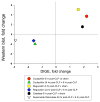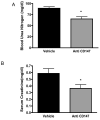Liver proteomics for therapeutic drug discovery: inhibition of the cyclophilin receptor CD147 attenuates sepsis-induced acute renal failure
- PMID: 17944020
- PMCID: PMC2278121
- DOI: 10.1097/01.ccm.0000281858.44387.a2
Liver proteomics for therapeutic drug discovery: inhibition of the cyclophilin receptor CD147 attenuates sepsis-induced acute renal failure
Abstract
Objective: Sepsis-induced multi-organ failure continues to have a high mortality. The liver is an organ central to the disease pathogenesis. The objective of this study was to identify the liver proteins that change in abundance with sepsis and subsequently identify new drug targets.
Design: Proteomic discovery study and drug target validation. For the proteomics study, three biological replicate mice were used per group.
Setting: Research institute laboratory.
Subjects: Three-month-old C57BL/6 mice.
Interventions: We used a mouse model of sepsis based on cecal ligation and puncture, but with fluid and antibiotic resuscitation. Liver proteins that changed in abundance were identified by difference in gel electrophoresis. We compared liver proteins from 6-hr post-cecal ligation and puncture to sham-operated mice ("early proteins") and 24-hr post-cecal ligation and puncture with 6-hr post-cecal ligation and puncture ("late proteins"). Proteins that changed in abundance were identified by tandem mass spectrometry. We then inhibited the receptor for one protein and determined the effect on sepsis-induced organ dysfunction.
Results: The liver proteins that changed in abundance after sepsis had a range of functions such as acute phase response, coagulation, endoplasmic reticulum stress, oxidative stress, apoptosis, mitochondrial electron transfer proteins, and nitric oxide metabolism. We found that cyclophilin increased in abundance after cecal ligation and puncture. When the receptor for this protein, CD147, was inhibited, sepsis-induced renal dysfunction was reduced. There was also a significant reduction in serum cytokine production when CD147 was inhibited.
Conclusion: By applying proteomics to a clinically relevant mouse model of sepsis, we identified a number of novel proteins that changed in abundance. The inhibition of the receptor for one of these proteins, cyclophilin, attenuated sepsis-induced acute renal failure. The application of proteomics to sepsis research can facilitate the discovery of new therapeutic targets.
(C) 2007 Lippincott Williams & Wilkins, Inc.
Figures










Comment in
-
Mining the liver proteome for drug targets for sepsis.Crit Care Med. 2007 Oct;35(10):2443-4. doi: 10.1097/01.CCM.0000285451.40021.26. Crit Care Med. 2007. PMID: 17885383 No abstract available.
Similar articles
-
Delayed Mitogen-Activated Protein Kinase/Extracellular Signal-Regulated Kinase Inhibition by Trametinib Attenuates Systemic Inflammatory Responses and Multiple Organ Injury in Murine Sepsis.Crit Care Med. 2016 Aug;44(8):e711-20. doi: 10.1097/CCM.0000000000001672. Crit Care Med. 2016. PMID: 27031380 Free PMC article.
-
Biomarker and drug-target discovery using proteomics in a new rat model of sepsis-induced acute renal failure.Kidney Int. 2006 Aug;70(3):496-506. doi: 10.1038/sj.ki.5001575. Epub 2006 Jun 7. Kidney Int. 2006. PMID: 16760904 Free PMC article.
-
Cecal Ligation and Puncture Alters Glucocorticoid Receptor Expression.Crit Care Med. 2018 Aug;46(8):e797-e804. doi: 10.1097/CCM.0000000000003201. Crit Care Med. 2018. PMID: 29787416
-
Sepsis-induced organ failure is mediated by different pathways in the kidney and liver: acute renal failure is dependent on MyD88 but not renal cell apoptosis.Kidney Int. 2006 Mar;69(5):832-6. doi: 10.1038/sj.ki.5000165. Kidney Int. 2006. PMID: 16518342 Free PMC article.
-
Therapeutic effects of hypertonic saline on peritonitis-induced septic shock with multiple organ dysfunction syndrome in rats.Crit Care Med. 2008 Jun;36(6):1864-72. doi: 10.1097/CCM.0b013e318173f982. Crit Care Med. 2008. PMID: 18496380
Cited by
-
The roles of CD147 and/or cyclophilin A in kidney diseases.Mediators Inflamm. 2014;2014:728673. doi: 10.1155/2014/728673. Epub 2014 Dec 17. Mediators Inflamm. 2014. PMID: 25580061 Free PMC article. Review.
-
Repressing CD147 is a novel therapeutic strategy for malignant melanoma.Oncotarget. 2017 Apr 11;8(15):25806-25813. doi: 10.18632/oncotarget.15709. Oncotarget. 2017. PMID: 28445958 Free PMC article. Review.
-
The dysfunction of complement and coagulation in diseases: the implications for the therapeutic interventions.MedComm (2020). 2024 Oct 23;5(11):e785. doi: 10.1002/mco2.785. eCollection 2024 Nov. MedComm (2020). 2024. PMID: 39445002 Free PMC article. Review.
-
Potential Alternative Receptors for SARS-CoV-2-Induced Kidney Damage: TLR-4, KIM-1/TIM-1, and CD147.Front Biosci (Landmark Ed). 2024 Jan 12;29(1):8. doi: 10.31083/j.fbl2901008. Front Biosci (Landmark Ed). 2024. PMID: 38287815 Free PMC article. Review.
-
Pharmacokinetic Parameters of Recombinant Human Cyclophilin A in Mice.Eur J Drug Metab Pharmacokinet. 2024 Jan;49(1):57-69. doi: 10.1007/s13318-023-00871-3. Epub 2023 Dec 1. Eur J Drug Metab Pharmacokinet. 2024. PMID: 38040985
References
-
- Szabo G, Romics L, Jr, Frendl G. Liver in sepsis and systemic inflammatory response syndrome. Clin Liver Dis. 2002;6:1045–66. - PubMed
-
- Hanash S. Disease proteomics. Nature. 2003;422:226–232. - PubMed
-
- Unlu M, Morgan ME, Minden JS. Difference gel electrophoresis: a single gel method for detecting changes in protein extracts. Electrophoresis. 1997;18:2071–2077. - PubMed
-
- Lilley KS, Friedman DB. All about DIGE: quantification technology for differential-display 2D-gel proteomics. Expert Rev Proteomics. 2004;1:401–409. - PubMed
-
- Miyaji T, Hu X, Yuen PS, Muramatsu Y, Iyer S, Hewitt SM, Star RA. Ethyl pyruvate decreases sepsis-induced acute renal failure and multiple organ damage in aged mice. Kidney Int. 2003;64:1620–1631. - PubMed
Publication types
MeSH terms
Substances
Grants and funding
LinkOut - more resources
Full Text Sources
Medical

